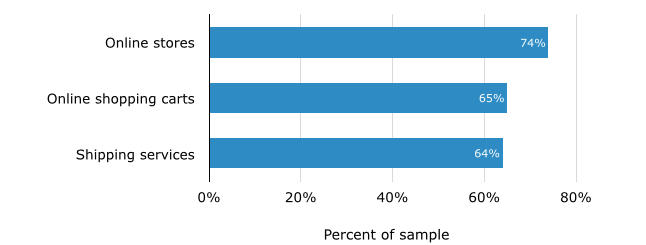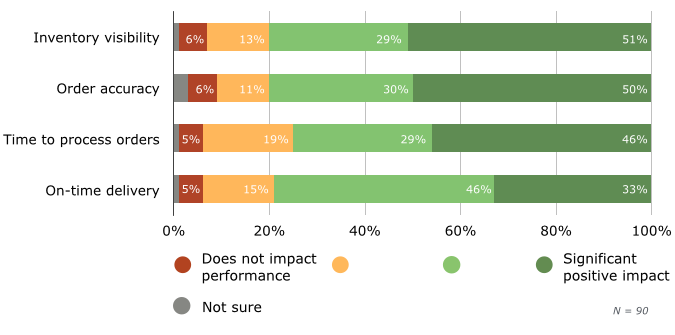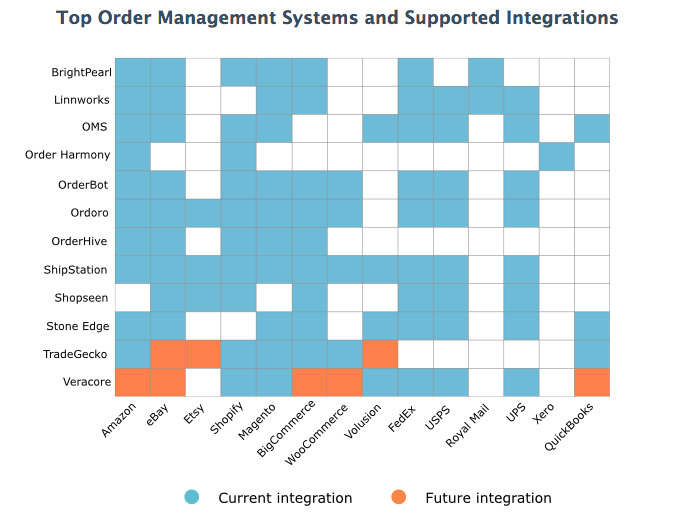Last week, we covered part of Software Advice’s research on how integrated order management systems can impact ecommerce performance. But that was only the first wheel of their findings; let’s tackle the rest.
The Wheels on the Ecommerce Business Go Round and Round
There are multiple parts to an online retailer’s business that keeps it rolling, but which is most used along with an order management system? Software Advice, a software consulting company, asked merchants which order management integrations they used – online stores (Amazon, eBay, Etsy), shopping carts (Shopify, Bigcommerce, WooCommerce), and shipping services (USPS, FedEx, etc). The options were likely ranked so closely because merchants use a variety of integrations, many of which are interconnected with one another.
Most Common Order Management System Integrations
It makes perfect sense that online stores like Amazon or eBay would be the most utilized order management integration, since a sales channel is pretty much the starting point for wheeling and dealing in the ecommerce world. As time goes on and a business grows, a logical step towards increasing sales, expanding the business, and building the brand is opening an additional sales channel, and merchants are likely opening online stores rather than shopping carts because marketplaces typically already have the audience ready-to-go. When that sales channel is launched, it can simply link with the order management tool along with the others.
But shipping services aren’t a third wheel to an ecommerce business by any means. If you’re going to open various sales channels, you will likely need a shipping service integration to control the time spent getting orders out. They’re a close second to online shopping carts by 1%, and that’s likely because they’re nearly essential for merchants looking to reduce the administrative nightmare of sending out products. Plus, if an order management is dealing with orders, it may as well help handle shipping too.
Never Asleep Behind the Wheel
No ecommerce merchant is going to risk being asleep behind the wheel of their inventory levels; they’re constantly monitoring how much of a product is in stock, how much money is sitting in inventory, and their ability to fulfill. As a result, an order management system that’s able to maintain high visibility of inventory throughout all your channels in a single location is pretty important.
When Software Advice’s research covered how an order management system integrated with shopping carts affected aspects, like inventory visibility, and time to process and fulfill orders, the results showed significant positive impacts:
Effects of Order Management Systems Integrated with Shopping Carts
It makes perfect sense that an order management system allows for increased visibility, especially for shopping carts, because its most basic purpose is to track all orders in one place. And that boosted visibility can feed into other benefits, like better order accuracy, and improved turnaround time in processing and delivering. At the end of the day, order management systems are able to offer the above perks due thanks to their ability to integrate with different cart providers that would otherwise be isolated from one another. If you’re on Shopify and Etsy, the two aren’t going to link together, but each’s order information can be collected in one place: the order management system.
Wheel… of… Integrations!
If an ecommerce merchant is going to invest in an order management system, they won’t be spinning a wheel and landing on one – they’ll make their choice based on compatibility with their channels. That’s why order management systems typically integrate with as many sales and supplier channels as feasible for them. The more integrations they’ve got, the more customers that can potentially use the product. Take a look below at just what integrations most major providers support:
Vanna White did a poor job finishing this puzzle for us, but you get the point (integration with QuickBooks is also a future integration for us!). Most leading order management systems thrive off their ability to connect with a variety of marketplaces and shopping carts, and if they call themselves ‘multichannel,’ they had better link with as many channels as possible. Because of that, the phrase “play nice” is the name of the game.
All the Wheels in Motion
Order management systems are simply another solution in the ecommerce ecosystem that keeps all the wheels of an ecommerce business in motion. Long story short, they exist to help a merchant better manage their online store, and they’re especially important for multichannel retailers that need to collect information from a variety of channels. Below are four main perks to order management systems that online retailers generally experience:
Business visibility: with a comprehensive view of your orders across all your channels, it’s far easier to know exactly what’s occurring in your business, and where.
Task automation: instead of plugging in data from each channel into one place for analysis, order management systems automatically compile it in a single app.
Order accuracy: systems integrated with channels reduce the chance for a merchant to mix up an order as they operate on multiple carts and marketplaces.
Turnaround time: at the end of the day, regardless of integration, order management systems deliver time-saving benefits to merchants that speed up the daily grind of handling orders.





